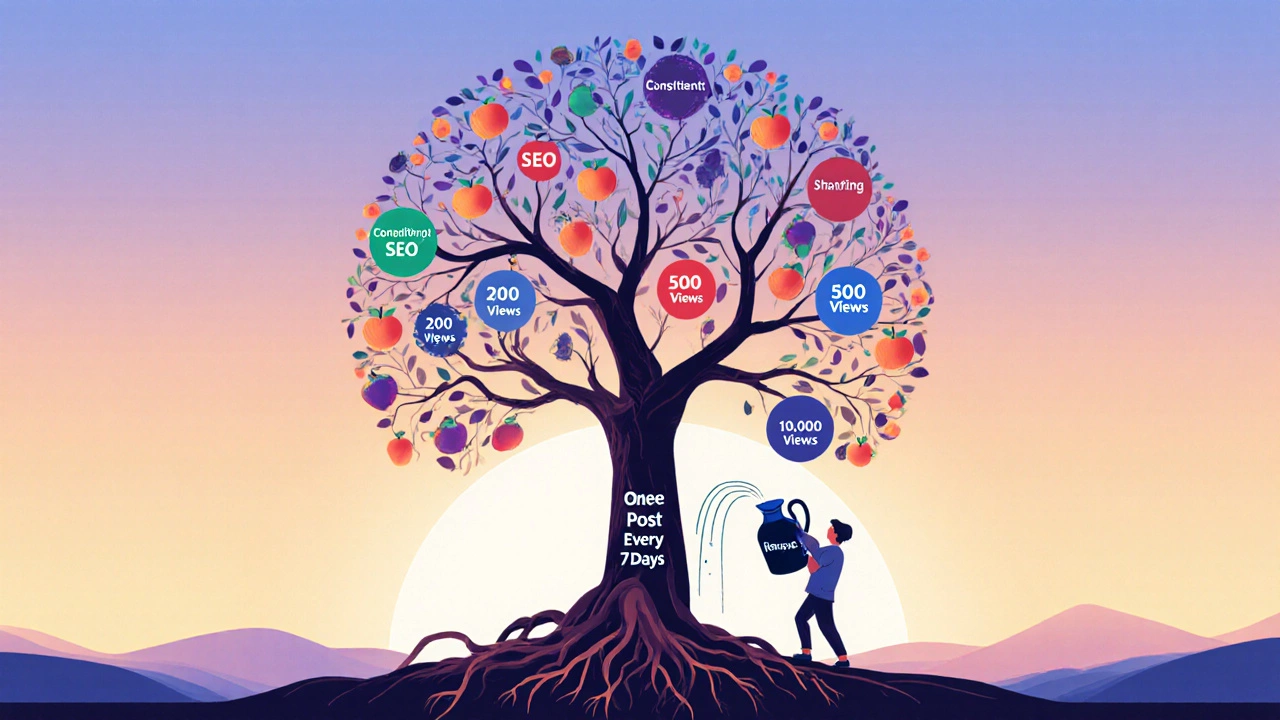Blog Traffic Growth Calculator
Estimate how many views your blog could get by following the article's proven strategy. Enter your publishing frequency, average views per post, and sharing platforms to see your growth potential.
Getting 1,000 views on your blog doesn’t need luck. It doesn’t need a viral post or a famous name. It just needs consistency, strategy, and a few smart moves most bloggers ignore. If you’ve been writing for weeks and still see under 50 views per post, you’re not doing anything wrong-you’re just missing key pieces of the puzzle.
Start with a topic people are already searching for
Most bloggers write what they like. That’s fine for personal journals. But if you want views, you need to write what people are already looking for. Google Trends, AnswerThePublic, and even the search bar in YouTube or Reddit can show you what questions people are asking right now.
For example, instead of writing “My Journey to Mindfulness”, write “How to stop overthinking at night (5 simple tricks)”. The second one answers a specific problem. People type that into Google. The first one? No one searches for it.
Use free tools like Ubersuggest or Google Keyword Planner to check search volume. Look for keywords with 100-1,000 monthly searches. That’s your sweet spot. High competition? Skip it. Too low? Not worth it. You want something people are actively typing in.
Write longer posts-but only if they add value
Long-form content still wins. Posts between 1,500 and 2,500 words get 3x more traffic than short ones, according to a 2024 Backlinko study. But length isn’t magic. It’s about depth.
A 2,000-word post that repeats the same idea five times won’t help. A 2,000-word post that answers every possible follow-up question? That’s gold.
Structure your posts like this:
- State the problem clearly
- Explain why it matters
- List 3-5 proven solutions
- Give real examples (even if they’re small)
- End with a clear takeaway
People scroll fast. Make it easy for them to find what they need. Use subheadings. Bullet points. Bold key phrases. If they can’t scan your post in 30 seconds, they’ll leave.
Optimize for Google like you mean it
SEO isn’t a buzzword. It’s your traffic engine. If your blog doesn’t show up on page one of Google, it doesn’t exist to most people.
Here’s what actually works in 2025:
- Put your main keyword in the first 100 words
- Use it in your H1 and at least one H2
- Write a meta description that sounds like a human wrote it-not a robot
- Include related keywords naturally (like “blog traffic,” “increase blog views,” “how to grow a blog”)
- Add internal links to your other posts
- Link out to one or two high-authority sites (like Harvard Business Review or HubSpot)
And don’t forget images. Every post needs at least one original image. Use Canva to make simple graphics. Add alt text with your keyword: “how-to-get-blog-views-step-by-step.” Google indexes those.

Share your post where your readers already hang out
Posting on your blog is step one. Sharing it is step two. And step two gets you views.
Don’t just post your link on Twitter and call it a day. Go where your audience is.
For example:
- If you wrote about sleep tips, join Reddit threads in r/sleep or r/insomnia. Answer questions. Then say, “I wrote a detailed guide on this-here’s the link if it helps.”
- If you wrote about productivity for students, find Facebook groups for university students. Don’t spam. Engage first. Help someone. Then share your post when relevant.
- Use Pinterest. Create a vertical image with your title and a simple graphic. Pin it to relevant boards. Pinterest sends steady traffic for months.
One blogger in London got 800 views in 3 weeks just by sharing 5 blog posts in 3 Reddit communities. No ads. No budget. Just time and patience.
Repurpose one post into 5 pieces of content
Why write one post and let it sit? Turn it into five things:
- A short video for TikTok or Instagram Reels (15-30 seconds, summarizing one tip)
- Three Twitter/X threads breaking down each step
- An email newsletter version for your list (even if it’s just 10 people)
- A LinkedIn post with a personal story about why you wrote it
- A quote graphic for Instagram Stories
Each piece drives traffic back to your blog. One person sees your Reel, clicks through. Another sees your tweet, clicks through. You’re not relying on one channel-you’re multiplying your reach.

Be patient. But track your progress
Getting 1,000 views doesn’t happen overnight. But it happens faster than you think if you’re consistent.
Set a simple goal: publish one high-quality post every 7 days. Share it in two places. Repeat.
After 4 weeks, you’ll have 4 posts. If each gets 200-300 views, you’re already at 1,000. And each new post builds on the last. Your older posts start ranking. Your traffic compounds.
Use Google Analytics to track what’s working. Look at:
- Which posts got the most views?
- Where did the traffic come from? (Google, Reddit, Pinterest?)
- What keywords brought people in?
Double down on what works. Drop what doesn’t. No emotion. Just data.
Stop chasing perfection. Start shipping
Most bloggers wait for the perfect post. Perfect headline. Perfect design. Perfect timing. Meanwhile, their blog stays empty.
Done is better than perfect. A good post published today beats a perfect post published in six months.
Look at your favorite blogs. Most of them started with rough posts. They improved over time. You can too.
Write your next post. Publish it. Share it. Then write the next one. Repeat. In 60 days, you’ll have 8 posts. And you’ll be surprised how many views add up.
